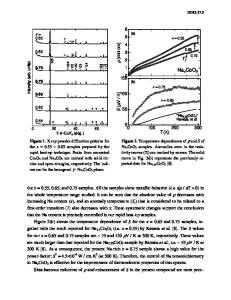Synthesis and Thermoelectric Properties of Na x Co 2 O 4 Single Crystals
- PDF / 292,544 Bytes
- 7 Pages / 612 x 792 pts (letter) Page_size
- 35 Downloads / 311 Views
0886-F02-04.1
Synthesis and Thermoelectric Properties of NaxCo2O4 Single Crystals Xiaofeng Tang1, Kelvin Aaron2, Edward Abbott3, Joseph W. Kolis3, Terry M. Tritt2 1. Dept. of Material Science & Engineering, Clemson University, Clemson, SC, 29634 2. Dept. of Physics and Astronomy, Clemson University, Clemson, SC, 29634 3. Dept. of Chemistry, Clemson University, Clemson, SC, 29634 ABSTRACT Single crystal NaCo2O4 platelets with sizes up to 6mm were synthesized by the typical high temperature NaCl flux method. The in-plane thermopower α and in-plane resistivity ρ were measured to be ~100µV/K and 0.3mΩ-cm at 300K, respectively. The in-plane thermal conductivity κ was measured by our custom-designed “PTC” system and found to be ~5 W-m1 -1 K at 300K, which is 2-3 times larger than the polycrystalline NaCo2O4. The in-plane phonon mean free path lph was estimated to be ~9.5Å, which is much smaller than the in-plane mean free path of conducting carriers (la~51Å). A novel low temperature flux method where NaCl/NaOH was used as flux and metallic Co powders as Co source was developed to successfully synthesize Na-deficient NaxCo2O4 crystals with size up to 6mm at low temperature of 550oC. The different temperature dependence in resistivity reveals that two different types of crystals can exist, one is metallic and another is semiconducting. The temperature dependence of the measured κ is like that of a disordered solid and the value is found to be ~7 W-m-1K-1 at 300K. 1. INTRODUCTION Thermoelectric (TE) materials can convert heat into electricity through Seebeck effect; also electricity can be converted into thermal energy via Peltier effect. The performance of thermoelectric materials, which is proportional to device efficiency, can be evaluated by the dimensionless figure-of-merit (FOM) which is defined as ZT =
α 2T ρ (κ L + κ e )
(1)
where α is the Seebeck coefficient, also called thermopower, ρ is the resistivity, κL and κe is lattice and electronic thermal conductivity, respectively. It’s difficult to increase the efficiency of device since ZT is the combination of transport properties of materials and the three transport parameters α, ρ, κ are correlated. The traditional TE theory considers oxides possessing low mobility as a dirty TE material. However, in 1997 Terasaki reported [1] a new transition-metal oxide, NaCo2O4 with unexpected favorable TE properties. The NaCo2O4 single crystal was found to be potential as a good p-type TE with low metallic in-plane resistivity 0.2 mΩ-cm and large thermopower 100 µV/K, even though the mobility is quite low, 13 cm2/V-s. Its power factor (α2T/ρ) value of 1.5 W-m-1K-1 is even larger than that of Bi2Te3, 1.2 W-m-1K-1 at 300K. The NaxCo2O4 oxide material has a hexagonal layered structure with edge-sharing 2D triangle CoO2 sheets and Na layers alternately stacked along c-axis. The CoO2 sheet, which is conducting and strongly electron correlated, appears to be the source of the small metallic
0886-F02-04.2
electrical resistivity and large thermopower value. Wang et al. proposed [2
Data Loading...











